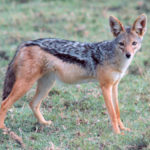Facts about Bengal tigers
 Bengal tigers hunt wild boars, roe deer, deer (spotted, barassing, Indian zambar), antelope (nilgau antelope), goats, buffaloes and gaurs, young elephants, leopards, red wolves, jackals and foxes, crocodiles, and also small vertebrates (frogs, fish, badgers, monkeys, porcupines, snakes, birds) and insects (termites). Do not disdain and carrion.
Bengal tigers hunt wild boars, roe deer, deer (spotted, barassing, Indian zambar), antelope (nilgau antelope), goats, buffaloes and gaurs, young elephants, leopards, red wolves, jackals and foxes, crocodiles, and also small vertebrates (frogs, fish, badgers, monkeys, porcupines, snakes, birds) and insects (termites). Do not disdain and carrion.- Males do not eat fish and rabbits, females do – on the contrary – eagerly eat fish and offal.
- In one sitting, an adult Bengal tiger can eat up to 40 kg of meat, and then starve for up to three weeks.
- The Bengal tiger is nocturnal. The hearing is well developed, perfectly seen in the dark. Active at dusk and at dawn. Tigers sleep up to 16-18 hours a day.
- Tigers are excellent swimmers and climb the trees. Can jump up to 9 m!
- At short distances develop a speed of up to 60 km / h.
- The Bengal tiger is very patient, watches the victim for a long time and waits for a convenient moment to make one decisive throw.
- A small prey kills a bite in the neck, and a large choke on the throat. Extraction transfers to a safe place (sometimes up to 450 m) to eat quietly.
- Except for the breeding season, the Bengal tiger leads a solitary lifestyle. The area of an individual site occupies from 30 to 3000 km2.
- The border of the site male marks his urine, feces and “scrapes”. Their territory is actively protected by the tigers. A section of the male can partially overlap with several sections of females. Female Bengal tigers are less territorial, sometimes the landlady allows another female to hunt in its territory.
- The female gives birth to 2-4 helpless blind kittens (there are twins). Lactation lasts up to 6-8 weeks, and then the mother begins to feed tiger meat. At the age of 11 months, cubs can hunt independently, but usually they stay with their mother until they are 1.5-3 years old.




























